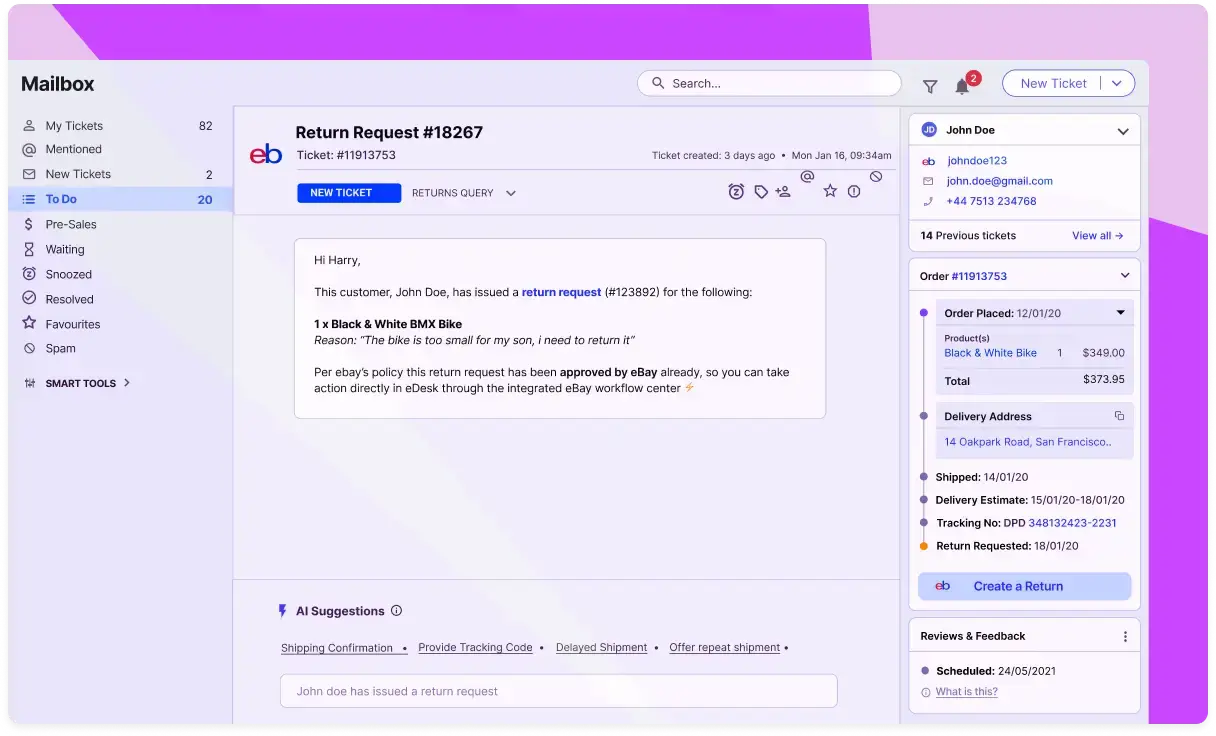In the bustling world of e-commerce, customer satisfaction is king. One aspect that certainly sways this satisfaction needle is how effectively an organization manages refunds and returns. However, tackling this issue can often feel akin to solving a Rubik’s Cube while blindfolded—an intricate puzzle packed full of financial implications, operational hassles, and potential consequences on customer loyalty.
But fret not! I am here to guide you through the complexities of managing refunds and returns in the eCommerce world. We are going to explore proven strategies for streamlining your returns process, understanding its impact on your business bottom line, creating hassle-free policies that resonate with customers, and leveraging technology tools designed specifically for returns management. Ready for the journey? Then let’s dive in!
Understanding refunds and returns
The importance of effectively managing refunds and returns
Let’s begin our exploration by highlighting why effective management of eCommerce refunds and returns is so important. Firstly, it directly affects your company’s reputation—a poorly managed return process can leave customers dissatisfied, resulting in unfavorable reviews about your brand spreading across the internet like wildfire.
The financial impact of eCommerce refunds and returns
Neglecting to manage product returns efficiently can inflict severe financial blows on your e-commerce enterprise. According to a study conducted by Statista, online retail platforms in the United States had merchandise return rates are ~16.5%. Handling eCommerce returns comes with costs like transportation fees, staff time, and warehousing expenses for sorting items. Also, when a refund is requested, you lose the original sale value, which negatively impacts your overall revenue.
Customer experience and satisfaction
Customer satisfaction is key in eCommerce, and a smooth return process is crucial for a great shopping experience—it screams top-tier customer service! Shoppers tend to feel more confident about making purchases knowing the safety net of a hassle-free return policy exists. Efficient returns signal your dedication to superior service and encourage repeat business. In fact, when effectively managed, returning customers are likely to spend 67% more than first-time buyers.
On the flip side, complex return procedures may frustrate customers, leading them to competitors with more lenient policies.
Return policy development and communication
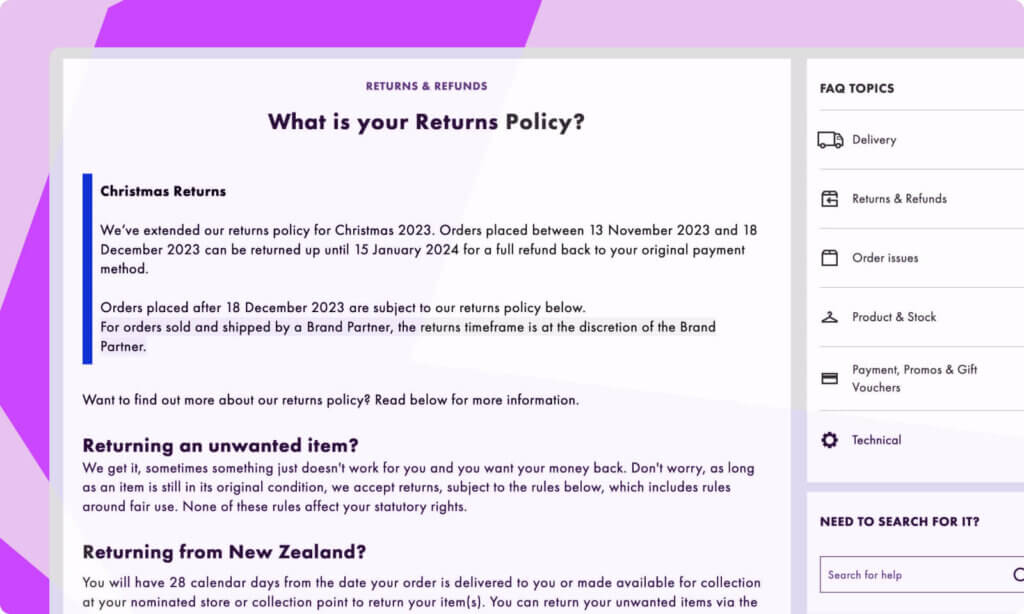
Developing a robust returns’ strategy in e-commerce begins with crafting a clear and concise return policy. This significantly influences customer satisfaction and brand perception and reinforces your commitment to providing top-notch service.
Creating a clear and concise return policy
To create an effective policy, clearly outline acceptable reasons for returns, such as unsatisfactory products, defects, or incorrect shipments. Specify the return timeframe for better customer planning and inventory management.
Clearly state reimbursement methods (store credit, replacements), return item conditions (unused, original packaging), and who pays for shipping to set clear expectations and prevent negative experiences. Include contingencies for international returns if applicable, especially for more complex procedures.
Communicating your return policy to customers
Ensure your return policy is clear and easily accessible to customers. Display it on your website, either in the footer or via banners on checkout pages, facilitating self-service and reducing customer service load. Use common phrases in the policy text for better understanding and SEO, attracting more traffic.
Incorporate visual content like guides or videos to aid customers who prefer non-textual information. Communicate the policy through email, including links in order confirmations and shipping notifications, and consider including a summary in the package for heightened awareness.
Educating employees on your return policy and procedures
Train employees thoroughly in your return policies to ensure consistent implementation during customer interactions. Provide customer service teams with guidelines and scripts for empathetic yet assertive communication, especially during disagreements, to maintain professionalism.
Frontline staff handling ecommerce queries should be knowledgeable about the return process to ensure uniform responses across touchpoints, enhancing brand image. These efforts are crucial for effective refunds and returns management, fostering positive customer perception, loyalty, and repeat purchases.
Implementing an efficient return process
Crafting a highly efficient return process is key to customer satisfaction and overall business success. As we dive into the steps involved in handling return requests, we will explore tools and technologies for streamlining the process and some invaluable tips for boosting efficiency.
Steps involved in handling a return request
Initiating a product return starts with a customer’s dissatisfaction or need for change. To help turn unhappy customers into happy ones, ease of execution is paramount.
- Customer request submission: the first step starts with enabling customers to easily submit their rightful return requests on your ecommerce platform. An online form can capture necessary details such as purchase details, reason for return, preferred refund method, etc
- Request review and approval: carefully review the submitted information to ensure it aligns with your set policy. Once a customer return has been approved, the last thing any business wants to do is revoke approval after realizing it doesn’t comply with your returns’ policy further along the process. In this instance, your business would likely have to take the financial hit to protect your relationship with the customer.
- Product collection or drop-off: based on approval of the request, arrange merchandise pickup from customers or provide them easy drop-off options at your returns warehouse.
- Evaluation of returned product: once received, thoroughly inspect products to establish their condition – whether damaged, defective or good-as-new – which often dictates whether they are re-sellable or not.
- Refund execution: upon successful verification of returned goods—the final step would usually involve issuing appropriate refunds based on prior agreed terms during purchase confirmation.
Tools and technologies for streamlining the return process
A vast range of technology exists today to support the quest for efficient returns management—ranging from simple independent software tools to complex integrated solutions within various ecommerce platforms—we have everything to automate time-consuming tasks while ensuring accuracy.
Return management software (RMS): Simplify all aspects of handling returned products by automatically validating returns against your policies; tracking inventory data; processing refunds quickly and updating related data in real time.
Automated email platforms: This tool is critical for maintaining clear communication with customers on latest updates regarding their return requests—be it approval notices or confirmations of completed refunds.
eCommerce Customer support software: Fully integrate your returns’ solution into your support software. This helps maintain a unified, transparent system while benefiting from insights arising from customer behavior trends in relation to returns.
Adopting these technologies brings about better organization and faster return handling times. Ultimately, this results in increased satisfaction among returning customers.
Learn more about eDesk:
Managing refunds
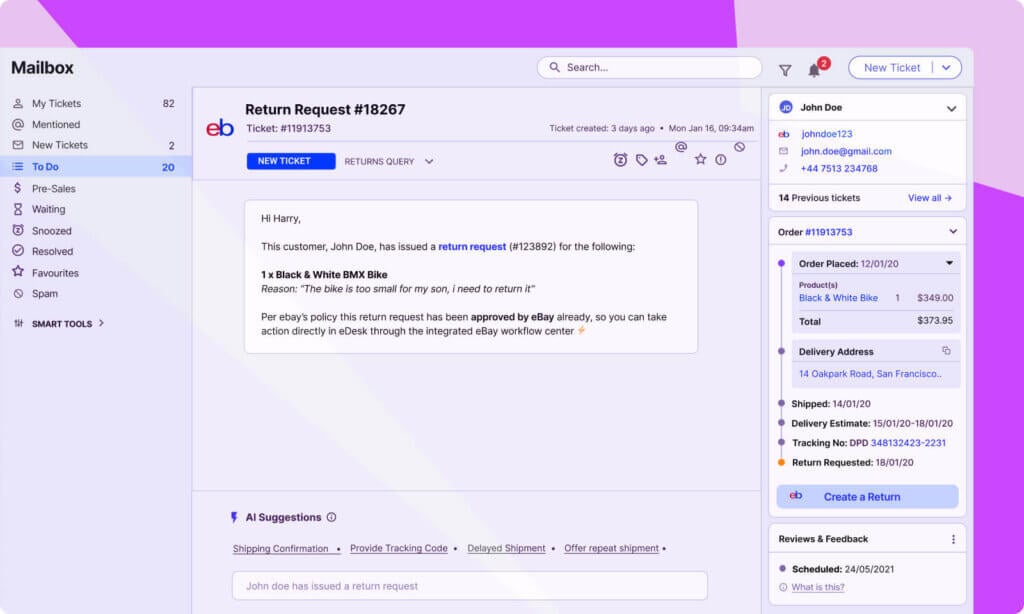
Refunds can often be a complex part of running an e-commerce business. However, they are crucial to customer satisfaction and maintaining your reputation. Let’s delve into how you can streamline this process and make it painless for both you and the customer.
Factors to consider when determining refund eligibility
A clear understanding of what qualifies a product for a refund is necessary. Here are some common factors that businesses consider while determining refund eligibility:
- Reason for return: This could be due to defects, damage during transit, incorrect items shipped, or simply because the customer changed their mind.
- Condition of the item: Products that are unopened and in their original packaging are usually eligible for refunds.
- Return window: Establish a specific period after purchase during which returns can be entertained. Typical return windows range from 14 days to 30 days.
- Evidence of purchase: receipts, email confirmations or invoices help validate claims.
Considering these factors with every ‘returns management’ decision ensures fair treatment to customers while protecting your business from unnecessary losses.
Methods for issuing refunds
Once a product is deemed as eligible for a return, exploring ample options on how to issue refunds becomes pertinent:
- Cash refund: Reimbursing cash might seem straightforward but keeping track of financial transactions is crucial.
- Credit card refunds: If the initial payment was made by credit card, refunds usually go back onto the same card.
- Store credit: Offering store credit encourages customers to continue shopping with you while improving your cash flow.
- Gift cards: Similar to store credits, gifting cards can also serve as promotional tools, encouraging future purchases.
Achieving consumer satisfaction and ensuring business profitability is a balancing act when it comes to returns, and how customers are reimbursed for their returns must be carefully considered based on each return circumstance.
Best practices for timely refund processing
Focus your efforts on providing prompt reimbursement, whether it be store credit or a credit card refund, it needs to be processed in a timely manner. Efficiently managing refunds can help turn an unsatisfied customer into a happy customer who is more likely to make repeat purchases.
- Have a clear policy: An ambiguous return policy can invite unnecessary confusion for the customer and your customer support agents, making the review and approval process longer than it needs to be. Keep it precise, understandable and easy-to-find on your website.
- Quick recognition of returns: Use an organized ‘return process’ system that promptly recognizes when a returned product enters your ‘returns warehouse’.
- Expedite refunds: Today’s consumers expect fast turnarounds; the quicker you can process their refund, the better. If you communicate a refund processing time, make sure you stick to it, so the customer doesn’t need to chase it up.
- Communicate promptly: Confirm receipt of returns and keep customers informed about the progress of their refund.
Keep in mind, taking a proactive approach to refunds helps avoid potential disputes and brings you closer to gaining lifelong brand advocates!
Reducing return rates
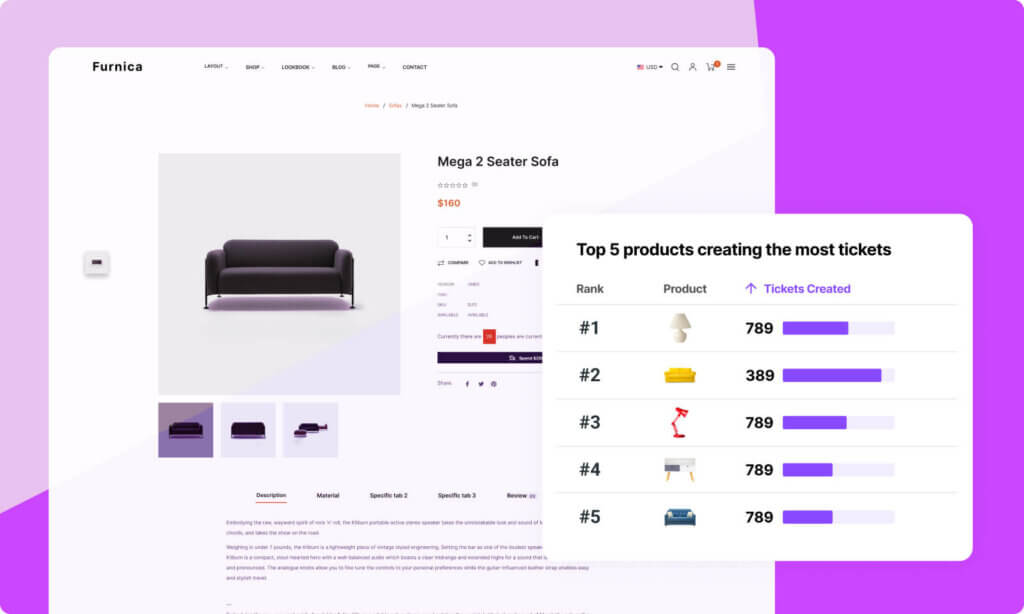
No business thrives on returns, especially not in the e-commerce landscape where return costs can drastically eat into profits, as previously discussed. Therefore, there’s a compelling need to focus as much energy on reducing return rates as efficiently managing refunds and returns. Here’s how.
Identify root cause of returns
Concrete data plays a crucial role in identifying the root causes of product returns. Combining an insightful analysis of product quality with candid customer feedback provides invaluable insights into why customers resort to returning your products.
It is vital at this stage that you do not ignore issues arising from logistics like sustainability, packaging meddling or damage during transport. These are all areas that could impact your return rate.
Proactively address common reasons for returns
Having identified what’s causing recurrent returns from customers, it is crucial for any forward-thinking business owner to now proactively address and resolve these issues.
For instance, if it becomes apparent that a particular product isn’t meeting customer expectations due to inconsistent sizing information, it would be wise to reevaluate the accuracy of product descriptions.
When assessing the quality of product listings, it’s important to consider aspects such as;
- Detailed product descriptions: it’s not enough to have just the basics; your customers should know exactly what they’re buying. Invest time in crafting comprehensive descriptions that cover all aspects of your items.
- High-quality images: clear, sharp images from multiple angles will give potential buyers a virtual sense of your product’s look and feel. By including photographs depicting scale relative to common objects, you diminish uncertainty about size dimensions.
- Precise sizing charts: especially crucial for clothing businesses, providing accurate sizing information reduces instances of goods ‘not fitting.’ take time to gather reliable measurements for each size variant of your apparel.
Implementing quality control measures.
Implementing a robust quality assurance process can prevent defective products from reaching your e-commerce platform or customers. By ensuring only high-quality, functional items are delivered, you reduce returns due to dissatisfaction from broken or substandard goods. While stringent quality checks may initially increase time and overheads, they lead to lower return rates and long-term benefits. Such strategic actions streamline your business, increase customer satisfaction, reduce returns, and boost profits.
Offer pre-purchase consultations to clarify customer expectations
In some instances, pre-purchase consultations can help guide customers toward the most suitable product to reduce the likelihood of a return request. This is more relevant for high-value or technical products where a expert advice could address common pre-purchase concerns
- Product demos: whether it’s hosted on your website, or live-scheduled sessions for potential buyers, demos function as firsthand experience without physical handling.
- Consultation and Q&A sessions: consultants can directly respond to specific queries about how the product fits particular needs. It assures them you’re a customer-centric business seeking their best interest, which always bodes well for brand reliability.
Handling product exchanges

Swapping out one product for another is a common occurrence in the realm of e-commerce. These transactions require a different approach compared to standard returns. Among other things, maintaining an efficient process necessitates well laid-out policies and thorough inventory management.
Policies and procedures for facilitating product exchanges
Seamless product exchange management requires clear policies and procedures. Outline conditions for exchanges, such as incorrect size, color, or damaged items. Establish eligibility criteria and provide a detailed guide on how customers can request exchanges, streamlining the process for efficiency and reduced customer support strain.
Ensure transparency by stipulating exchange initiation timelines and clarifying return shipping costs – whether they are refunded or borne by customers. Address specific scenarios like exchanges for clearance items, including any restrictions on replacement options. Ensure staff members are fully informed about every aspect of product exchanges to handle them efficiently and prevent disputes.
Managing availability of exchange items
Managing eCommerce exchanges is complex, particularly with inventory issues. Ensure swift movement of returned items into resale-ready stock to maintain availability for exchanges. Real-time stock tracking is crucial to minimize the delay between exchange requests and shipment. Implement systems for continuous, accurate inventory monitoring.
Integrating your inventory management with your returns’ system streamlines tracking of returned products, avoiding issues from disjointed systems. This integration is key for efficient exchange execution.
Investing in integrated inventory management tools enhances service delivery in product exchanges. Balance clear exchange policies with up-to-date inventory records. An efficient system reduces customer frustration from unavailable exchanges, building loyalty and encouraging repeat business. Remember, satisfied customers are likely to become repeat buyers.
Managing damaged or defective products
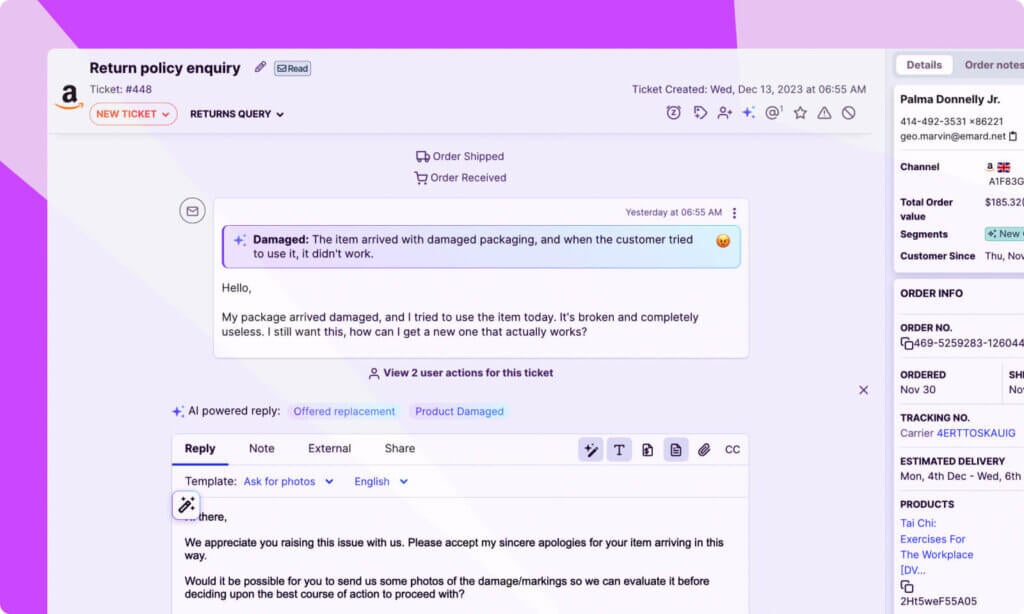
Every business inevitably faces the circumstance of dealing with damaged or defective product returns. How you respond can greatly influence customer trust and your brand’s reputation. In this segment, let’s dive into effective strategies to manage such situations.
Procedures for handling damaged or defective product returns
Establishing clear procedures for managing the return of damaged or defective products is crucial to prevent chaos and maintain operational efficiency, whilst ensuring quality issues don’t have a lasting impact on your customers’ perception of your brand.
- Promptly acknowledge:When a customer reports a faulty product, promptly acknowledging their concern builds trust and recognizes their dissatisfaction.
- Verify return: Conduct an authenticity check to ensure the returned item originated from your stock and the customer has a valid transaction record.
- Inspect & classify: Verify if the product is genuinely defective or was mishandled by customers—we don’t want to treat genuine faults the same as human errors.
- Provide a resolution: After classification, promptly action the appropriate solution—whether it’s a refund, repair, or replacement—based on factors discussed in subsequent sections:
Repair vs. replacement considerations for damaged products
Deciding whether to repair or replace a defective product can have considerable implications, both economically and in terms of customer satisfaction.
- If the cost of repair surpasses the value of the product itself, undoubtedly, replacing over repair should be favored.
- Time is also a crucial factor, as customers prefer prompt resolutions. If the repair process takes significantly longer than replacement, it may further inconvenience customers.
- However, in some cases where high-value goods are concerned (like electronics), where replacement drives substantial costs upon businesses, careful analysis becomes pivotal in deciding whether to opt for the quickest or most cost-effective solution.
Coordinating with suppliers or manufacturers for resolving warranty-related issues
Collaboration with suppliers and manufacturers often determines how well you can uphold after-sales promises made to your customers during purchase.
Remember these strategies for effective coordination:
- Maintain transparent communication: discuss all warranty-related issues that you face while solving return requests—warranty terms, claim duration, or reimbursement policies.
- Emphasize data sharing: continuous exchange of product quality feedback helps suppliers detect and rectify weaknesses in manufacturing processes.
- Uphold proactive relationship management: nurture relationships with your vendors. The more vested they feel in your success, the more cooperative they will be when it comes to warranty claims or replacements.
Managing damaged or defective products doesn’t always have to be a burden; view this process as an opportunity to earn unwavering customer support instead! We can convert these challenging situations into milestones that elevate our online reputation and gain customer loyalty, essential for sustainable business growth.
Utilizing technology in return management
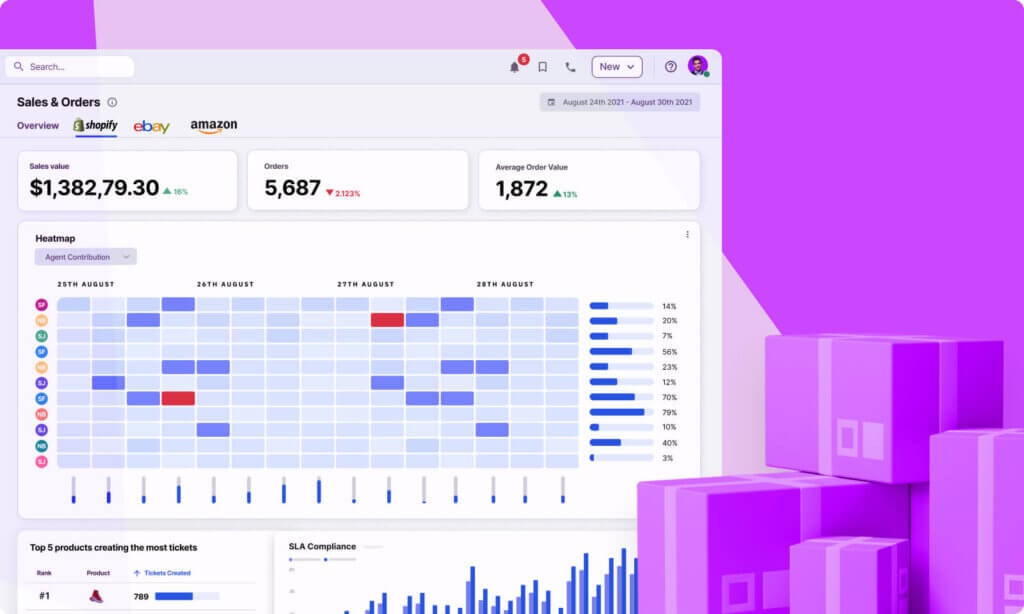
In today’s digital era, technology serves as a vital force driving this efficiency in eCommerce returns
Automation, software, and data analytics play critical roles in managing refunds and returns. Automation transforms business operations by handling repetitive tasks such as issuing refund notifications and updating returned product information. This saves time, reduces human error, and accelerates processing times, enhancing customer satisfaction.
Dedicated software systems are vital for managing returns. A well-implemented returns solution offers comprehensive visibility into the entire process, from the initial request to receipt, inspection, and final actions like restocking or disposal.
Data analytics adds value by providing insights into trends behind product returns. Analyzing return rates for different products and the most common reasons for returns helps businesses develop data-driven strategies. This approach not only minimizes future returns but also improves product offerings and customer experiences.
Key features to look for when selecting a return management system.
- Seek software that provides real-time tracking of every returned item.
- Ensure that it can easily integrate with your current sales channels and wider eCommerce tech stack.
- Make sure it provides robust analytics features that deliver insights on performance metrics such as reasons for returns and repeat offense customers.
- Opt for easy-to-use systems, both for employees actioning the return and customers who would need to initiate their return processes.
- Consider platforms like eDesk designed specifically for eCommerce customer service needs.
Remember that the end goal is achieving increased efficiency in managing returns from customers, without compromising customer experience.
Integration with inventory management and customer relationship management systems
Integrating your return management system with inventory and CRM tools creates a unified, efficient platform. This integration automatically updates inventory levels based on returns and enables direct communication with customers about their requests. It also leverages CRM capabilities to strengthen relationships with customers, especially those dissatisfied, through efficient and caring handling of refunds and returns.
In conclusion, utilizing technology like automation, dedicated eCommerce support solutions like eDesk, and data analytics, along with smart cross-platform integration, can greatly streamline managing refunds and returns in e-commerce. This approach enhances operational efficiency and improves customer satisfaction and retention.
The role of customer service in return management
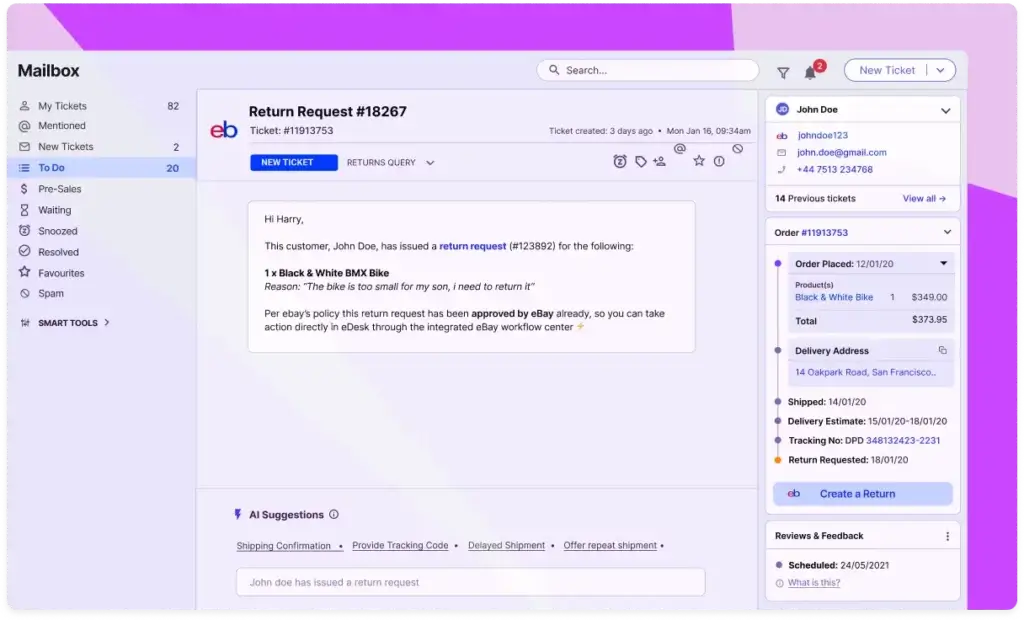
A cornerstone of any effective strategy in managing eCommerce refunds and returns is a focus on customer service. Key elements in this domain include the crucial training of customer service representatives, emphasizing empathy, ensuring effective communication, and providing alternative solutions.
Training customer service representatives on handling refund and return requests
Effective return management hinges on a well-prepared staff with the necessary knowledge and skills. Firstly, employees must be well-versed in every step of the return process to provide accurate assistance to clients. It’s vital they understand how to use internal systems like eDesk for efficient management of refund-related tickets, enabling quick access to customer details or order histories.
Incorporating role-playing exercises in training sessions is beneficial, particularly for challenging scenarios. These exercises simulate real-world situations involving eCommerce returns, giving agents practical experience to handle diverse scenarios they may face. This approach enhances problem-solving skills and improves customer interactions, leading to more efficient and satisfactory return processes.
Empathy and effective communication in resolving customer complaints or concerns
This is critical for eCommerce returns when you consider that the only physical interaction the customer may have had with your brand is with the product they are unhappy with and wish to return. Empathy and clear communication from your support agents can help to introduce a human element to your brand that is often lost behind online transactions. This can play an instrumental role in resolving customer complaints relating to returns in a way that leaves a lasting positive impression.
Empathy enables representatives to put themselves in the shoes of customers frustrated by defective products or incorrect orders. By recognizing and acknowledging their emotions accurately, your team members can make customers feel heard and respected.
Effective communication goes hand in hand with this empathetic approach. Clear responses void of industry jargon are essential for avoiding confusion, while maintaining transparency about your policies regarding manage returns is also critical. Promoting active listening may yield positive results as well, as it extends respect towards customers by genuinely valuing what they have to say.
Providing alternative solutions
Being proactive is crucial in reducing customer dissatisfaction with product returns, especially as eCommerce returns by nature involve a much longer returns process than in-store returns.
For instance, if stock issues prevent an immediate product exchange or refund, offering alternative solutions like store credit or a discount on future purchases could dissuade disappointment.
Furthermore, service representatives could even suggest complementary products as substitutes based on the customer’s purchase history and preferences in situations where the ordered item is no longer available.
In conclusion, integrating these considerations into your returns management approach can potentially boost satisfaction levels among customers tackling unwanted merchandise returns – ultimately contributing to increased loyalty and repeat patronage.
Legal considerations in refunds and returns
Regardless of the size of your e-commerce business, it is vital to understand that managing refunds and returns isn’t solely about customer satisfaction or financial implications. It also involves legal aspects that every business owner should be aware of.
Knowing consumer protection laws and regulations related to refunds and returns
Understanding consumer protection laws governing refunds and returns in your market jurisdiction is crucial. In the U.S., companies must comply with Federal Trade Commission (FTC) guidelines for eCommerce businesses. These rules emphasize transparency, requiring online retailers to clearly communicate their return process, including timelines for refunds, store credit, or exchanges.
Additionally, state-specific regulations may apply, especially for items like perishables or customized products. If operating globally, familiarize yourself with regulations in other regions, such as the Distance Selling Regulations in the European Union or the Australian Consumer Law for sales in Australia.
Compliance is not optional; non-adherence can lead to penalties with a significant impact on your business. It’s important to either thoroughly understand these laws or work with a legal expert knowledgeable in eCommerce operations to ensure compliance and protect your business.
Addressing potential liabilities or obligations for product recalls or defects
Addressing faulty merchandise returns due to design issues or manufacturing defects is crucial. Understanding liabilities and obligations related to product recalls ensures fair practices and consumer safety. In recall scenarios, responsibilities increase as public health and brand reputation are at risk. To mitigate this, adopt rigorous quality control measures during production to minimize the circulation of defective products.
When defects originate from third-party manufacturers, it’s essential to have explicit contracts defining responsibilities. Coordinating with suppliers to resolve defects and handle warranty claims is a key part of returns management.
Managing refunds and returns isn’t just about customer service; it involves a deep understanding of laws and potential liabilities. These aspects significantly impact your e-commerce business’s reputation, customer loyalty, and finances. A well-informed and proactive approach is vital for successful eCommerce operations.
Ongoing assessment and improvement of return management strategies

Strategically handling returns is an ongoing process that demands continual refinement to strike a balance between customer satisfaction and operational efficiency. Think of it this way, you can’t always prevent an eCommerce return request, but you can ensure the customer’s return experience is a positive one through efficient processes.
Monitoring feedback from customers regarding the return experience
A key component in managing refunds and returns effectively involves regularly collecting and analyzing feedback from customers. However, this isn’t just about asking for their input; it’s about actively listening to what they’re telling you.
Regularly survey your customers about their return experiences, or encourage them to rate and review your return process online. You could also set up channels, like an email address or contact form, dedicated solely to returns-related feedback.
It’s essential not to dismiss negative comments about the return experience. Instead, treat these complaints as invaluable insights that highlight areas in need of improvement—areas that might be overlooked otherwise.
Take proactive steps based on your findings. Remember, the purpose of soliciting reviews is not just to accumulate them, but to use them as a practical guide for enhancing your overall return policy over time.
Periodic evaluation of return rates, trends, and areas for improvement
Regularly analyzing return trends is crucial for e-commerce operations. By reviewing data on product returns, including periods with high return rates, you can assess the effectiveness of your current return management system.
Allocate resources to identify inefficiencies, especially for products with consistently high refund costs, like processing fees or reshipping charges. Audits in these areas can reveal opportunities for policy adjustments.
Focus not only on individual instances but also on broader trends. If analytics show a high rate of defective returns from a specific product line or consistent customer dissatisfaction with the return process, it indicates an urgent need for attention and potential changes. This proactive approach helps in refining return policies and improving overall customer satisfaction.
Conclusion
Navigating refunds and returns in e-commerce involves developing effective policies, implementing efficient practices, and continuously monitoring and improving processes. A holistic approach is key, focusing on clear policies, efficient procedures, and robust systems for handling returns, which can lead to significant operational efficiencies and enhanced customer experiences.
Technology plays a crucial role, with automated systems and dedicated platforms simplifying tasks and providing valuable insights. Effective communication within the team and with customers is essential for clarity and reducing frustrations.
Regular assessment of your refund and return process is vital to adapt to changing consumer behavior, new laws, and unique e-commerce challenges. Continuous refinement based on feedback enhances service quality.
By integrating these strategies into operational frameworks, businesses can achieve customer satisfaction, minimize financial impacts of returns, stay competitive, and build brand loyalty. Success in the dynamic online commerce sector depends on foresight and proactive approaches to improve the post-purchase journey.
